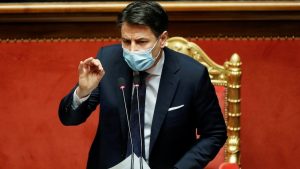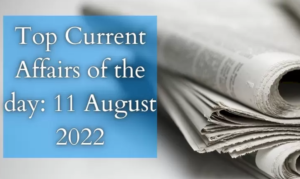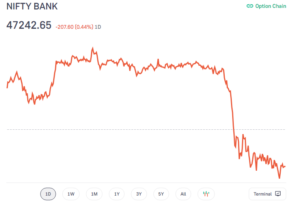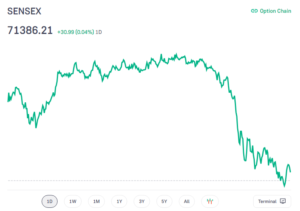
PM Modi Chairs 35th PRAGATI Meet
Prime Minister Narendra Modi has chaired the 35th PRAGATI meeting to review multiple projects, grievances and programmes. In the meeting, ten agenda items were taken for review worth Rs. 54,675 crore, related to 15 states. These included nine projects and one programme. Prime Minister also reviewed the Pradhan Mantri Bhartiya Jan Aushadhi Pariyojana.
About the meeting:
- PRAGATI stands for Pro-Active Governance and Timely Implementation.
- Of the total 9 projects, 3 projects were from the Ministry of Railways, 3 from Ministry of Road Transport and Highways and 1 project each from Department of Promotion of Industry and Internal Trade, Power Ministry and Ministry of External Affairs.
- The States are Odisha, Karnataka, Andhra Pradesh, Maharashtra, Chhattisgarh, Punjab, Jharkhand, Bihar, Telangana, Rajasthan, Gujarat, West Bengal, Haryana, Uttarakhand, and Uttar Pradesh.
India Secures 86th Rank in Corruption Perception Index 2020
India has been ranked 86th among 180 countries in the Corruption Perception Index (CPI) 2020, released by Transparency International. This year, India’s rank has slipped six places compared to 2019, when it was ranked at 80th spot. The CPI score for India in 2020 is 40. India is sharing its position jointly with Burkina Faso, Morocco, East Timor, Trinidad and Tobago and Turkey.
Top Country:
New Zealand and Denmark have jointly secured the first position with scores of 88.
Lowest Country:
Somalia and South Sudan rank lowest at 179th position with scores of 12.
CPI Index:
The CPI index ranks 180 countries and territories by their perceived levels of public sector corruption according to experts and business people. The index uses a scale of 0 to 100, where 0 is highly corrupt and 100 is very clean.
Important takeaways for all competitive exams:
- Transparency International Headquarters location: Berlin, Germany.
- Transparency International Chairperson: Delia Ferreira Rubio.
- Transparency International Founded: 4 May 1993.
India Ranks 86 among 98 Countries in Lowy Institute’s Covid-19 Response Index
India has been ranked at 86th position among 98 countries in the new Coronavirus Performance Index released by Australia-based Lowy Institute. Countries were ranked based on the publicly available and comparable data on Covid-19 response. The Lowy Institute is an independent international policy think tank, located in Sydney.
New Zealand, Vietnam and Taiwan are the top three countries respectively in the index. Brazil was ranked at the bottom of the list for worst handling of the pandemic than any other country. China was excluded from the list due to lack of publicly available data.
Lt Gen Chandi Prasad Mohanty appointed as new Army Vice-Chief
Lieutenant General Chandi Prasad Mohanty has been appointed as the new Vice-chief of Army staff. He would assume the office on February 1, 2021, from Lt General SK Saini, who is superannuating on 31 January 2021. Lt General CP Mohanty is an alumnus of Rashtriya Indian Military College, Dehradun, and National Defence Academy. He is a June 1982 batch Infantry Officer from the Rajput Regiment.
About the Vice-Chief of Army Staff:
Vice-Chief of Army Staff is the deputy head and the second-highest-ranking officer of the Indian Army. The position is held by the senior officer in the rank of Lt-General, of the Commander in Chief grade.
Important takeaways for all competitive exams:
- 28th Chief of Army Staff: General Manoj Mukund Naravane.
- The motto of Indian Army: “Service Before Self”.
- Headquarters of Indian Army: New Delhi.
Swaminathan Janakiraman and Aswini Kumar Tewari appointed as MDs of SBI
The appointments committee (ACC) of the Cabinet has approved the appointment of Swaminathan Janakiraman and Ashwini Kumar Tewari as new Managing Directors (MDs) of State Bank of India (SBI) for a period of three years. Prior to this, Swaminathan Janakiraman was the deputy managing director (Finance) at SBI and Ashwini Kumar Tewari was serving as MD & CEO of SBI Card, a subsidiary of SBI.
SBI is headed by a Chairman and four managing directors. Dinesh Kumar Khara is the current Chairman of the bank. The other two MDs of the bank are C.S. Setty and Ashwani Bhatia. The two posts were vacant since October 2020.
Important takeaways for all competitive exams:
- State Bank of India Headquarters: Mumbai; Founded: 1 July 1955.
Reliance Jio ranked 5th strongest brand globally
Billionaire Mukesh Ambani’s four-year-old telecom venture Reliance Jio has been ranked the fifth strongest brand globally behind the likes of Ferrari and Coca-Cola. As per the ranking, Reliance Jio has emerged as the 5th strongest brand in the world. Reliance Jio has made its entry to the world’s strongest brands. Reliance has been ranked as the 5th strongest brand in the world. It has a Brand Strength Index (BSI) score of 91.7 out of 100.
About the Brand Finance Global 2021:
The Brand Finance’s Global 500 ranking of the strongest brands globally, which determined the relative strength of brands, is topped by WeChat, according to its annual report on most valuable and strongest global brands.
According to the Report:
- As per the Brand Finance Global 500 2021 ranking, Apple has been named as the most valuable brand in the world.
- The brand value of the company is US$263.4 billion. Amazon is the second most valuable brand followed by Google.
- TATA has retained its spot as the most valuable brand of India. It has been placed at the 77th position globally and has a brand value of US$21.3 billion.
- WeChat is the strongest brand in the world with a BSI score of 95.4. WeChat has surpassed Ferrari to rank as the strongest brand.
- Ferrari is the 2nd strongest brand in the world.
- Russian bank Sber and Coca-Cola are the 3rd and 4th strongest brands respectively.
India’s “Vaccine Maitri” Initiative begins
Vaccine Maitri Initiative is an initiative launched by India to gift COVID-19 vaccines to neighbouring countries. Recently, Sri Lanka and Bahrain have received the COVID-19 vaccines from India under the initiative. The Vaccine Maitri initiative was launched by India on January 20 to gift COVID-19 vaccines to neighbouring countries.
About the initiative:
- Sri Lanka has received 5 lakh Covid-19 vaccines from India as a part of the “Vaccine Maitri” initiative.
- Consignment of vaccines has also been sent to Bahrain. The country will receive 10,800 vaccines under the initiative.
- India has already delivered over 5 million doses to seven countries in the neighbourhood under the initiative before Sri Lanka and Bahrain.
- The 7 countries are- the Maldives (100,000 vaccines), Bhutan (150,000 vaccines), Nepal (1 million vaccines), Bangladesh (2 million vaccines), Myanmar (1.5 million vaccines), Mauritius (100,000 vaccines), and Seychelles (50,000 vaccines).
- Commercial supplies of Covishield have also been sent to Morocco, Brazil, (2 million doses each), and Bangladesh (5 million doses).
COVID-19 Vaccination in India:
The COVID-19 vaccination programme started in India on January 16, 2021, with the two approved vaccines (Emergency-use) – Covishield and Covaxin. In phase 1, health workers are being vaccinated followed by people above the age of 50 years.
Economic Survey 2021: Key highlights of Economic Survey
Finance Minister, Nirmala Sitharaman has presented Economic Survey 2020-21 in the Parliament on 29 January 2021. The major focus of this year’s economic survey is the losses and impact of the Covid-19 pandemic. The survey will provide an assessment of how the Indian economy has been impacted by the deadly COVID-19 virus and how it is improving. It will also project India’s gross domestic product growth for 2021-22.
The Economic Survey document is prepared by the Economics Division of the Department of Economic Affairs (DEA) under the guidance of the Chief Economic Advisor Krishnamurthy Subramanian. The Economic Survey 2020-21 will be followed by the Union Budget 2020-21 which will be tabled on February 1.
The theme of Economic Survey, 2020-21:
- #SavingLives&Livelihoods
- #VshapedRecovery
What is the Economic Survey?
- The Economic Survey is an annual document of the Ministry of Finance. It reviews the economic progress of the country and issues in the last 12 months.
- The survey provides information related to the performance of key developmental schemes launched by the government. The document also explains the performance of major government policies and their impact.
- The Economic Survey discusses major fiscal developments, macroeconomic factors, inflation, and other economic factors. The document also highlights the impact of agriculture, climate change, and employment on the economy of the country.
- The 1st Economic Survey was tabled in 1950-51. However, till the year 1964, it was presented along with the budget.
Here are the key highlights from the Economic Survey 2020-21:
According to the survey, India’s economy could contract 7.7 per cent in the financial year that ends on March 31, pulled down mainly by the coronavirus pandemic and the weeks-long nationwide lockdown to contain the disease. Real GDP growth could be 11 per cent in the next financial year.
Saving Lives and Livelihoods amidst a Once-in-a-Century Crisis
- India focused on saving lives and livelihoods by its willingness to take short-term pain for long-term gain, at the onset of the COVID-19 pandemic.
Response stemmed from the humane principle that:
- Human lives lost cannot be brought back
GDP growth will recover from the temporary shock caused by the pandemic
- An early, intense lockdown provided a win-win strategy to save lives, and preserve livelihoods via economic recovery in the medium to long-term
- V-shaped recovery, as seen in a 7.5% decline in GDP in Q2 and recovery across all key economic indicators vis-à-vis the 23.9% GDP contraction in Q1
COVID pandemic affected both demand and supply:
- India was the only country to announce structural reforms to expand supply in the medium-long term and avoid long-term damage to productive capacities
- Calibrated demand-side policies to ensure that the accelerator is slowly pushed down only when the brakes on economic activities are being removed
- A public investment programme centred around the National Infrastructure Pipeline to accelerate the demand push and further the recovery
- The upturn in the economy, avoiding the second wave of infections – a sui generis case in strategic policymaking amidst a once-in-a-century pandemic
State of the Economy in 2020-21: A Macro View
- COVID-19 pandemic ensued global economic downturn, the most severe one since the Global Financial Crisis
- The lockdowns and social distancing norms brought the already slowing global economy to a standstill
- Global economic output estimated to fall by 3.5% in 2020 (IMF January 2021 estimates)
- Governments and central banks across the globe deployed various policy tools to support their economies such as lowering policy rates, quantitative easing measures, etc.
- India adopted a four-pillar strategy of containment, fiscal, financial, and long-term structural reforms.
- As per the advance estimates by NSO, India’s GDP is estimated to grow by (-) 7.7% in FY21 – a robust sequential growth of 23.9% in H2: FY21 over H1: FY2
- India’s real GDP to record an 11.0% growth in FY2021-22 and nominal GDP to grow by 15.4% – the highest since independence:
- Rebound to be led by the low base and continued normalization in economic activities as the rollout of COVID-19 vaccines gathers traction
- Government consumption and net exports cushioned the growth from diving further down, whereas investment and private consumption pulled it down
- The recovery in the second half of FY2020-21 is expected to be powered by government consumption, estimated to grow at 17% YoY
- Exports expected to decline by 5.8% and imports by 11.3% in the second half of the FY21
- India expected to have a Current Account Surplus of 2% of GDP in FY21, a historic high after 17 years
On the supply side, Gross Value Added (GVA) growth pegged at -7.2% in FY21 as against 3.9% in FY20:
- Agriculture set to cushion the shock of the COVID-19 pandemic on the Indian economy in FY21 with a growth of 3.4%
- Industry and services estimated to contract by 9.6% and 8.8% respectively during FY21
- India remained a preferred investment destination in FY 2020-21 with FDI pouring in amidst global asset shifts towards equities and prospects of quicker recovery in emerging economies:
- Net FPI inflows recorded an all-time monthly high of US$ 9.8 billion in November 2020, as investors’ risk appetite returned
- India was the only country among emerging markets to receive equity FII inflows in 2020
- Softening of CPI inflation recently reflects an easing of supply-side constraints that affected food inflation
- Mild contraction of 0.8% in investment (as measured by Gross Fixed Capital Formation) in 2nd half of FY21, as against 29% drop in 1st half of FY21
- Reignited inter and intrastate movement and record-high monthly GST collections have marked the unlocking of industrial and commercial activity
- The external sector provided an effective cushion to growth with India recording a Current Account Surplus of 3.1% of GDP in the first half of FY21:
- Strong services exports and weak demand leading to a sharper contraction in imports (merchandise imports contracted by 39.7%) than exports (merchandise exports contracted by 21.2%)
- Forex reserves increased to a level so as to cover 18 months worth of imports in December 2020
- External debt as a ratio to GDP increased to 21.6% at end-September 2020 from 20.6% at end-March 2020
- Ratio of forex reserves to total and short-term debt improved because of the sizable accretion in reserves
- V-shaped recovery is underway, as demonstrated by a sustained resurgence in high-frequency indicators such as power demand, e-way bills, GST collection, steel consumption, etc.
- India became the fastest country to roll-out 10 lakh vaccines in 6 days and also emerged as a leading supplier of the vaccine to neighbouring countries and Brazil
Does Growth lead to Debt Sustainability? Yes, But Not Vice- Versa!
Growth leads to debt sustainability in the Indian context but not necessarily vice-versa:
- Debt sustainability depends on the ‘Interest Rate Growth Rate Differential’ (IRGD), i.e., the difference between the interest rate and the growth rate
- Negative IRGD in India – not due to lower interest rates but much higher growth rates – prompts a debate on fiscal policy, especially during growth slowdowns and economic crises
- Active fiscal policy can ensure that the full benefit of reforms is reaped by limiting potential damage to productive capacity
- Fiscal policy that provides an impetus to growth will lead to a lower debt-to-GDP ratio
- Given India’s growth potential, debt sustainability is unlikely to be a problem even in the worst scenarios
- Desirable to use countercyclical fiscal policy to enable growth during economic downturns
- Active, counter-cyclical fiscal policy – not a call for fiscal irresponsibility, but to break the intellectual anchoring that has created an asymmetric bias against fiscal policy
Does India’s Sovereign Credit Rating Reflect Its Fundamentals? No!
- The fifth-largest economy in the world has never been rated as the lowest rung of the investment-grade (BBB-/Baa3) in sovereign credit ratings.
India’s sovereign credit ratings do not reflect its fundamentals:
- A clear outlier amongst countries rated between A+/A1 and BBB-/Baa3 for S&P/ Moody’s, on several parameters
- Credit ratings map the probability of default and therefore reflect the willingness and ability of the borrower to meet its obligations:
- India’s willingness to pay is unquestionably demonstrated through its zero sovereign default history
- India’s ability to pay can be gauged by low foreign currency-denominated debt and forex reserves
- Sovereign credit rating changes for India have no or weak correlation with macroeconomic indicators
- India’s fiscal policy should reflect Gurudev Rabindranath Tagore’s sentiment of ‘a mind without fear’
- Sovereign credit rating methodology should be made more transparent, less subjective and better attuned to reflect economies’ fundamentals
Inequality and Growth: Conflict or Convergence?
- The relationship between inequality and socio-economic outcomes vis-à-vis economic growth and socio-economic outcomes is different in India from that in advanced economies.
- Economic growth has a greater impact on poverty alleviation than inequality
- India must continue to focus on economic growth to lift the poor out of poverty
- Expanding the overall pie – redistribution in a developing economy is feasible only if the size of the economic pie grows
Healthcare takes centre stage, finally!
- COVID-19 pandemic emphasized the importance of the healthcare sector and its inter-linkages with other sectors – showcased how a health crisis transformed into an economic and social crisis
- India’s health infrastructure must be agile so as to respond to pandemics – healthcare policy must not become beholden to ‘saliency bias’
- National Health Mission (NHM) played a critical role in mitigating inequity as the access of the poorest to pre-natal/post-natal care and institutional deliveries increased significantly
- Emphasis on NHM in conjunction with Ayushman Bharat should continue
- An increase in public healthcare spending from 1% to 2.5-3% of GDP can decrease the out-of-pocket expenditure from 65% to 35% of overall healthcare spending
- A regulator for the healthcare sector must be considered given the market failures stemming from information asymmetry
- Mitigation of information asymmetry will help lower insurance premiums, enable the offering of better products and increase insurance penetration
- Information utilities that help mitigate the information asymmetry in the healthcare sector will be useful in enhancing overall welfare
- Telemedicine needs to be harnessed to the fullest by investing in internet connectivity and health infrastructure
Process Reforms
- India over-regulates the economy resulting in regulations being ineffective even with relatively good compliance with process
- The root cause of the problem of overregulation is an approach that attempts to account for every possible outcome
- Increase in complexity of regulations, intended to reduce discretion, results in even more non-transparent discretion
- The solution is to simplify regulations and invest in greater supervision which, by definition, implies greater discretion
- Discretion, however, needs to be balanced with transparency, systems of ex-ante accountability and ex-post resolution mechanisms
- The above intellectual framework has already informed reforms ranging from labour codes to removal of onerous regulations on the BPO sector
Regulatory Forbearance an emergency medicine, not staple diet!
- During the Global Financial Crisis, regulatory forbearance helped borrowers tide over temporary hardship
- Forbearance continued long after the economic recovery, resulting in unintended consequences for the economy
- Banks exploited the forbearance window for window-dressing their books and misallocated credit, thereby damaging the quality of investment in the economy
- Forbearance represents emergency medicine that should be discontinued at the first opportunity when the economy exhibits recovery, not a staple diet that gets continued for years
- To promote judgement amidst uncertainty, ex-post inquests must recognize the role of hindsight bias and not equate unfavourable outcomes to bad judgement or malafide intent
- An Asset Quality Review exercise must be conducted immediately after the forbearance is withdrawn
- The legal infrastructure for the recovery of loans needs to be strengthened de facto
Innovation: Trending Up but Needs Thrust, Especially from the Private Sector
- India entered the top-50 innovating countries for the first time in 2020 since the inception of the Global Innovation Index in 2007, ranking first in Central and South Asia, and third amongst lower-middle-income group economies
- India’s gross domestic expenditure on R&D (GERD) is lowest amongst top ten economies
- India’s aspiration must be to compete on innovation with the top ten economies
- The government sector contributes a disproportionately large share in total GERD at three times the average of top ten economies
- The business sector’s contribution to GERD, total R&D personnel and researchers is amongst the lowest when compared to top ten economies
- This situation has prevailed despite higher tax incentives for innovation and access to equity capital
- India’s business sector needs to significantly ramp up investments in R&D
- Indian resident’s share in total patents filed in the country must rise from the current 36% which is much below the average of 62% in top ten economies
- For achieving higher improvement in innovation output, India must focus on improving its performance on institutions and business sophistication innovation inputs
JAY Ho! PM‘JAY’ Adoption and Health outcomes
- Pradhan Mantri Jan Arogya Yojana (PM-JAY) – the ambitious program launched by Government of India in 2018 to provide healthcare access to the most vulnerable sections demonstrates strong positive effects on healthcare outcomes in a short time
- PM-JAY is being used significantly for high frequency, low-cost care such as dialysis and continued during the Covid pandemic and the lockdown.
Bare Necessities
- Access to the ‘bare necessities’ has improved across all States in the country in 2018 as compared to 2012
- It is highest in States such as Kerala, Punjab, Haryana and Gujarat while lowest in Odisha, Jharkhand, West Bengal and Tripura
- Improvement in each of the five dimensions viz., access to water, housing, sanitation, micro-environment and other facilities
- Inter-State disparities declined across rural and urban areas as the laggard states have gained relatively more between 2012 and 2018
- Improved disproportionately more for the poorest households when compared to the richest households across rural and urban areas
- Improved access to the ‘bare necessities’ has led to improvements in health indicators such as infant mortality and under-5 mortality rate and also correlates with future improvements in education indicators
- The thrust should be given to reduce variation in the access to bare necessities across states, between rural and urban and between income groups
- The schemes such as Jal Jeevan Mission, SBM-G, PMAY-G, etc. may design an appropriate strategy to reduce these gaps
- A Bare Necessities Index (BNI) based on the large annual household survey data can be constructed using suitable indicators and methodology at the district level for all/targeted districts to assess the progress on access to bare necessities.
Fiscal Developments
- India adopted a calibrated approach best suited for a resilient recovery of its economy from COVID-19 pandemic impact, in contrast with a front-loaded large stimulus package adopted by many countries
- Expenditure policy in 2020-21 initially aimed at supporting the vulnerable sections but was re-oriented to boost overall demand and capital spending, once the lockdown was unwound
- Monthly GST collections have crossed the Rs. 1 lakh crore mark consecutively for the last 3 months, reaching its highest levels in December 2020 ever since the introduction of GST
- Reforms in tax administration have begun a process of transparency and accountability and have incentivized tax compliance by enhancing honest tax-payers’ experience
- Central Government has also taken consistent steps to impart support to the States in the challenging times of the pandemic
External Sector
- COVID-19 pandemic led to a sharp decline in global trade, lower commodity prices and tighter external financing conditions with implications for current account balances and currencies of different countries
- India’s forex reserves at an all-time high of US$ 586.1 billion as on January 08, 2021, covering about 18 months worth of imports
- India experiencing a Current Account Surplus along with robust capital inflows leading to a BoP surplus since Q4 of FY2019-20
Improvement in debt vulnerability indicators:
- The ratio of forex reserves to total and short-term debt (original and residual)
- Ratio of short-term debt (original maturity) to the total stock of external debt.
- Debt service ratio (principal repayment plus interest payment) increased to 9.7% as at end-September 2020, compared to 6.5% as at end-March 2020
Rupee appreciation/depreciation:
- In terms of the 6-currency nominal effective exchange rate (NEER) (trade-based weights), Rupee depreciated by 4.1% in December 2020 over March 2020; appreciated by 2.9% in terms of real effective exchange rate (REER)
- In terms of 36-currency NEER (trade-based weights), Rupee depreciated by 2.9% in December 2020 over March 2020; appreciated by 2.2% in terms of REER
- RBI’s interventions in forex markets ensured financial stability and orderly conditions, controlling the volatility and one-sided appreciation of the Rupee
Initiatives were undertaken to promote exports:
- Production Linked Incentive (PLI) Scheme
- Remission of Duties and Taxes on Exported Products (RoDTEP)
- Improvement in logistics infrastructure and digital initiatives
Money Management and Financial Intermediation
- Accommodative monetary policy during 2020: repo rate cut by 115 bps since March 2020
- Systemic liquidity in FY2020-21 has remained in surplus so far. RBI undertook various conventional and unconventional measures like:
- Open Market Operations
- Long Term Repo Operations
- Targeted Long Term Repo Operations
- Gross Non-Performing Assets ratio of Scheduled Commercial Banks decreased from 8.21% at end-March, 2020 to 7.49% at end-September, 2020
- The monetary transmission of lower policy rates to deposit and lending rates improved during FY2020-21
- The recovery rate for the Scheduled Commercial Banks through IBC (since its inception) has been over 45%
Prices and Inflation
Headline CPI inflation:
- Averaged 6.6% during April-December, 2020 and stood at 4.6% in December 2020, mainly driven by rising in food inflation (from 6.7% in 2019-20 to 9.1% during April-December, 2020, owing to build up in vegetable prices)
- CPI headline and its subgroups witnessed inflation during April-October 2020, driven by the substantial increase in price momentum – due to the initial disruptions caused by COVID-19 lockdown
- Moderated price momentum by November 2020 for most subgroups, coupled with positive base effect helped ease inflation
The rural-urban difference in CPI inflation saw a decline in 2020:
- Since November 2019, CPI-Urban inflation has closed the gap with CPI-Rural inflation
- Food inflation has almost converged now
- Divergence in rural-urban inflation observed in other components of CPI like fuel and light, clothing and footwear, miscellaneous etc.
- During April-December, 2019 as well as April-December, 2020-21, the major driver of CPI-C inflation was the food and beverages group: Thali cost increased between June 2020 and November 2020, however a sharp fall in the month of December reflecting the fall in the prices of many essential food commodities
State-wise trend:
- CPI-C inflation increased in most of the states in the current year
- Regional variation persists
- Inflation ranged from 3.2% to 11% across States/UTs during June-December 2020 compared to (-) 0.3% to 7.6% during the same period last year.
- Food inflation driving overall CPI-C inflation due to the relatively more weight of food items in the index.
Steps were taken to stabilize the prices of food items:
- Banning of export of onions
- The imposition of a stock limit on onions
- Easing of restriction on imports of pulses
Gold prices:
- Sharp spike as investors turned to gold as a safe-haven investment amid COVID-19 induced economic uncertainties
- Compared to other assets, gold had considerably higher returns during FY2020-21
Consistency in import policy warrants attention:
- Increased dependence on imports of edible oils poses the risk of fluctuations in import prices
- Imports impacting production and prices of the domestic edible oil market, coupled with frequent changes in import policy of pulses and edible oils, add to confusion among farmers/producers and delay imports
Sustainable Development and Climate Change
- India has taken several proactive steps to mainstream the SDGs into the policies, schemes and programmes
- Voluntary National Review (VNR) presented to the United Nations High-Level Political Forum (HLPF) on Sustainable Development
- The localisation of SDGs is crucial to any strategy aimed at achieving the goals under the 2030 Agenda
- Sustainable development remains core to the development strategy despite the unprecedented COVID-19 pandemic crisis
- Eight National Missions under National Action Plan on Climate Change (NAPCC) focussed on the objectives of adaptation, mitigation and preparedness on climate risks
- India’s Nationally Determined Contributions (NDC) states that finance is a critical enabler of climate change action
- The financing considerations will therefore remain critical especially as the country steps up the targets substantially
- The goal of jointly mobilizing US$ 100 billion a year by 2020 for climate financing by the developed countries has remained elusive
- The postponement of COP26 to 2021 also gives less time for negotiations and other evidence-based work to inform the post-2025 goal
- Despite overall growth in the global bond markets, green bond issuance in the first half of 2020 slowed down from 2019, possibly as a result of the on-going COVID-19 pandemic
- International Solar Alliance (ISA) launched two new initiatives – ‘World Solar Bank’ and ‘One Sun One World One Grid Initiative’ – poised to bring about solar energy revolution globally
Agriculture and Food Management
- India’s Agricultural (and Allied Activities) sector has shown its resilience amid the adversities of COVID-19 induced lockdowns with a growth of 3.4% at constant prices during 2020-21 (first advance estimate).
- The share of Agriculture and Allied Sectors in Gross Value Added (GVA) of the country at current prices is 17.8% for the year 2019-20 (CSO-Provisional Estimates of National Income, 29th May 2020).
- Gross Capital Formation (GCF) relative to GVA showing a fluctuating trend from 17.7 % in 2013-14 to 16.4 % in 2018-19, with a dip to 14.7 % in 2015-16
- Total food grain production in the country in the agriculture year 2019-20 (as per Fourth Advance Estimates), is 11.44 million tonnes more than during 2018-19.
- The actual agricultural credit flow was ₹13,92,469.81 crores against the target of ₹13,50,000 crores in 2019-20. The target for 2020-21 was ₹15,00,000 crores and a sum of ₹ 9,73,517.80 crores was disbursed till 30th November 2020:
- 1.5 crore dairy farmers of milk cooperatives and milk producer companies’ were targeted to provide Kisan Credit Cards (KCC) as part of Prime Minister’s AatmaNirbhar Bharat Package after the budget announcement of February 2020
- As of mid January 2021, a total of 44,673 Kisan Credit Cards (KCCs) have been issued to fishers and fish farmers and an additional 4.04 lakh applications from fishers and fish farmers are with the banks at various stages of issuance
The Pradhan Mantri Fasal Bima Yojana covers over 5.5 crore farmer applications year on year:
- Claims worth Rs. 90,000 crore paid, as on 12th January 2021
- Speedy claim settlement directly into the farmer accounts through Aadhar linkage
- 70 lakh farmers benefitted and claims worth Rs. 8741.30 crores were transferred during COVID-19 lockdown period
- An amount of Rs. 18000 crore have been deposited directly in the bank accounts of 9 crore farmer families of the country in December 2020 in the 7th instalment of financial benefit under the PM-KISAN scheme
Fish production reached an all-time high of 14.16 million metric tons during 2019-20:
- GVA by the Fisheries sector to the national economy stood at ₹2,12,915 crores constituting 1.24% of the total national GVA and 7.28 % of the agricultural GVA
- Food Processing Industries (FPI) sector growing at an Average Annual Growth Rate (AAGR) of around 9.99 % as compared to around 3.12 % in Agriculture and 8.25 % in Manufacturing at 2011-12 prices during the last 5 years ending 2018-19.
Pradhan Mantri Garib Kalyan Anna Yojana:
- 80.96 crore beneficiaries were provided foodgrains above NFSA mandated requirement free of cost till November 2020.
- Over 200 LMT of foodgrains were provided amounting to a fiscal outgo of over Rs. 75000 Crores.
AatmaNirbhar Bharat Package:
- 5 kg per person per month for four months (May to August) to approximately 8 crores migrants (excluded under NFSA or state ration card) entailing subsidy of Rs. 3109 crores approximately
Industry and Infrastructure
- A strong V-shaped recovery of economic activity further confirmed by IIP data
- The IIP & eight-core index further inched up to pre-COVID levels
- The broad-based recovery in the IIP resulted in a growth of (-) 1.9 % in Nov-2020 as compared to a growth of 2.1 % in Nov-2019 and a nadir of (-) 57.3 % in Apr-2020
- Further improvement and firming up in industrial activities are foreseen with the Government enhancing capital expenditure, the vaccination drive and the resolute push forward on long-pending reform measures
- AatmaNirbhar Bharat Abhiyan with a stimulus package worth 15 % of India’s GDP announced
Doing Business Report (DBR)
- India’s rank in the Ease of Doing Business (EoDB) Index for 2019 has moved upwards to the 63rd position in 2020 from 77th in 2018 as per the
- India has improved its position in 7 out of 10 indicators
- Acknowledges India as one of the top 10 improvers, the third time in a row, with an improvement of 67 ranks in three years
- It is also the highest jump by any large country since 2011
Services Sector
- India’s services sector contracted by nearly 16 % during H1: FY2020-21, during the COVID-19 pandemic mandated lockdown, owing to its contact-intensive nature
- Key indicators such as Services Purchasing Managers’ Index, rail freight traffic, and port traffic, are all displaying a V-shaped recovery after a sharp decline during the lockdown
- Despite the disruptions being witnessed globally, FDI inflows into India’s services sector grew robustly by 34% Y-o-Y during April-September 2020 to reach US$ 23.6 billion
- The services sector accounts for over 54 % of India’s GVA and nearly four-fifths of total FDI inflow into India
- The sector’s share in GVA exceeds 50% in 15 out of 33 States and UTs, and is particularly more pronounced (greater than 85%) in Delhi and Chandigarh
- Services sector accounts for 48% of total exports, outperforming goods exports in the recent years
- The shipping turnaround time at ports has almost halved from 4.67 days in 2010-11 to 2.62 days in 2019-20
- The Indian start-up ecosystem has been progressing well amidst the COVID-19 pandemic, being home to 38 unicorns – adding a record number of 12 start-ups to the unicorn list last year
India’s space sector has grown exponentially in the past six decades:
- Spent about US$ 1.8 billion on space programmes in 2019-20.
- Space ecosystem is undergoing several policy reforms to engage private players and attract innovation and investment.
Social Infrastructure, Employment and Human Development
- The combined (Centre and States) social sector expenditure as % of GDP has increased in 2020-21 compared to last year.
- India’s rank in HDI 2019 was recorded at 131, out of a total 189 countries:
- India’s GNI per capita (2017 PPP $) has increased from US$ 6,427 in 2018 to US$ 6,681 in 2019
- Life expectancy at birth improved from 69.4 years in 2018 to 69.7 years in 201
- The access to the data network, electronic devices such as a computer, laptop, smartphone etc. gained importance due to online learning and remote working during the pandemic
- Major proportion of workforce engaged as regular wage/salaried in the urban sector during the period of January 2019-March 2020 (quarterly survey of PLFS)
- Government’s incentive to boost employment through AatmaNirbhar Bharat Rozgar Yojana and rationalization and simplification of existing labour codes into 4 codes
Low level of female LFPR in India:
- Females spending disproportionately more time on unpaid domestic and caregiving services to household members as compared to their male counterparts (Time Use Survey, 2019)
- Need to promote non-discriminatory practices at the workplace like pay and career progression, improve work incentives, including other medical and social security benefits for female workers
India’s fight against COVID-19:
- Initial measures of lockdown, social distancing, travel advisories, practising hand wash, wearing masks reduced the spread of the disease
- The country also acquired self-reliance in essential medicines, hand sanitisers, protective equipment including masks, PPE Kits, ventilators, COVID-19 testing and treatment facilities
- World’s largest COVID-19 vaccination drive commenced on 16th January 2021 using two indigenously manufactured vaccines.
Bharti AXA General Insurance launches ‘Krishi Sakha’ App for farmers
Bharti AXA General Insurance has launched Krishi Sakha App, a one-stop-shop for Indian farmers that offers them relevant information to cater to their daily farming needs. It also provides guidance to farmers to adopt best farming practices and enhance their productivity. The farmers through this app will also have access to the Pradhan Mantri Fasal Bima Yojana (PMFBY) portal for crop insurance-related information.
About the Bharti AXA ‘Krishi Sakha’:
- Bharti AXA ‘Krishi Sakha’ aims at helping Indian farmers make informed decisions through customized information related to their farming requirements.
- It shares relevant information about the scientific way of farming, crop cultivation, sowing, or harvesting of major crops. It guides the farmers about weather forecasting, market and crop prices and government schemes related to insurance and agriculture.
Important takeaways for all competitive exams:
- Bharti AXA General Insurance Established: 2008.
- Bharti AXA General Insurance Headquarters: Mumbai, Maharashtra.
- Bharti AXA General Insurance MD and CEO: Sanjeev Srinivasan.
- Bharti AXA General Insurance Tagline: Suraksha ka Naya Nazariya.
Italian Prime Minister Giuseppe Conte resigns
Italian Prime Minister, Giuseppe Conte resigned after losing his Senate majority, plunging the country into political uncertainty just as it’s battling the pandemic and a recession. He tendered his resignation to President Sergio Mattarella, the ultimate arbiter of Italian political crises, who invited him to stay on in a caretaker capacity pending discussions on what happens next.
Italy was the first European country to face the full force of the Covid-19 pandemic and has since suffered badly, with the economy plunged into recession and deaths still rising by around 400 a day. Parts of the country remain under partial lockdown, the vaccination programme has slowed and a deadline is looming to agree on plans to spend billions of euros in European Union recovery funds.
Important takeaways for all competitive exams:
- President of Italy: Sergio Mattarella.
- Capital of Italy: Rome; Currency of Italy: Euro.








